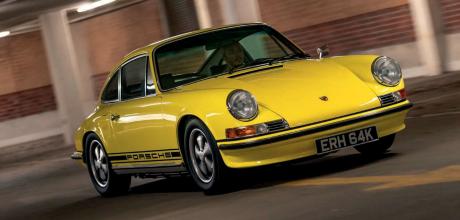1972 Porsche 911S 2.4 with RS 2.7 firepower
Subjected to comprehensive restoration using a wealth of rare unused Porsche parts, this early 911 S 2.4 benefits from exceptional attention to detail and additional poke provided by a flat-six built to Carrera RS 2.7 specification. Words Dan Furr. Photography Dan Sherwood.
A 1972 Porsche 911S 2.4 with RS 2.7 firepower
For the 1972 model year, Porsche updated the 911 with a new, larger 2.4-litre flat-six. In truth, displacement was 2,341cc, making the unit closer to 2.3 litres in capacity than the badge fixed to the engine lid grille would have admirers believe.
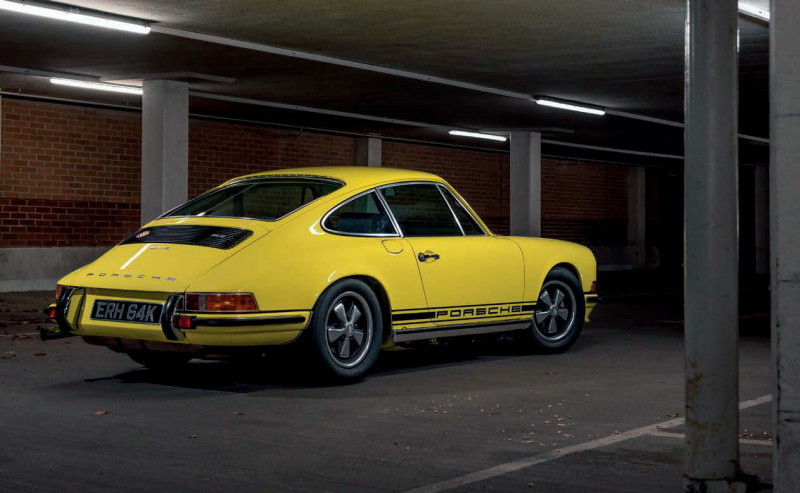
The entry level 911 T remained equipped with carburettors and delivered close to 130bhp, while the 911 E rewarded buyers with thirty more ponies and mechanical fuel injection. Sitting at the top of model hierarchy was the 911 S, also loaded with MFI, but turning a canter into a gallop by way of power knocking on the door of 190bhp. The punchy boxer, coupled with the then new 915 transmission (a unit with links to the 908 sports-prototype race car), not to mention hugely improved chassis dynamics and Porsche’s mainstream profile boosted by two successive overall wins at the 24 Hours of Le Mans, transformed the 911 into a sports car with much wider appeal than its maker had enjoyed previously. Moreover, lightweight construction, uncluttered looks and simple mechanicals ensured this short-lived generation of Porsche’s flagship product would go down in history as a firm fan favourite.
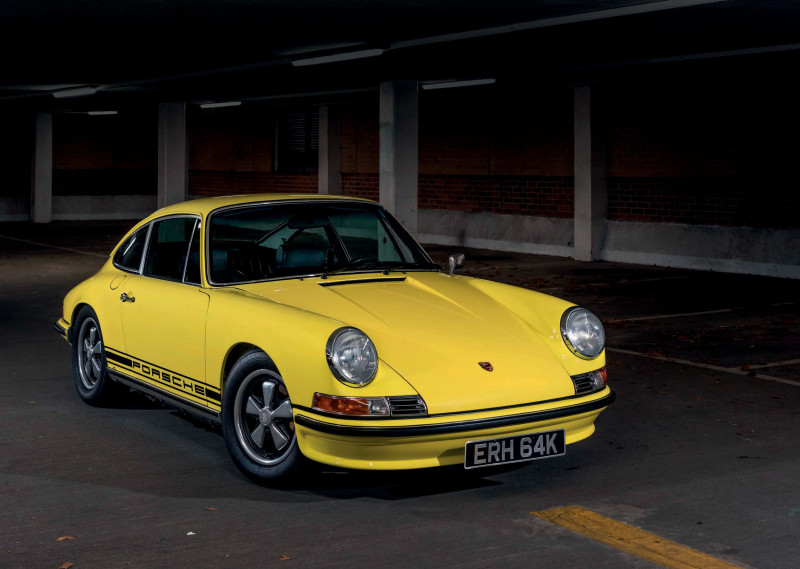
THERE ARE CERTAINLY OWNERS WHO WOULD BE LESS INCLINED TO USE A 911 SO UTTERLY FLAWLESS
In an effort to achieve improved handling, Porsche shifted the 911’s oil tank forward from behind the offside rear wheel, effectively moving mass toward the nose, resulting in more even distribution of weight. Consequently, an oil tank filler flap was added beneath the offside quarterlight. It’s a quirk of the 1972 model year, eliminated for 1973 — legend suggests the oil filler flap’s position, which is in keeping with where one would expect to find the fuel filler on a ‘regular’ car, confused enough fuel station attendants and unwitting owners to result in a high number of 911 oil tanks being pumped full of petrol. It’s thought only 1,430 911s were built in this configuration before the oil tank was returned to its original position in readiness for a wider round of revisions and arrival of the Carrera RS 2.7.
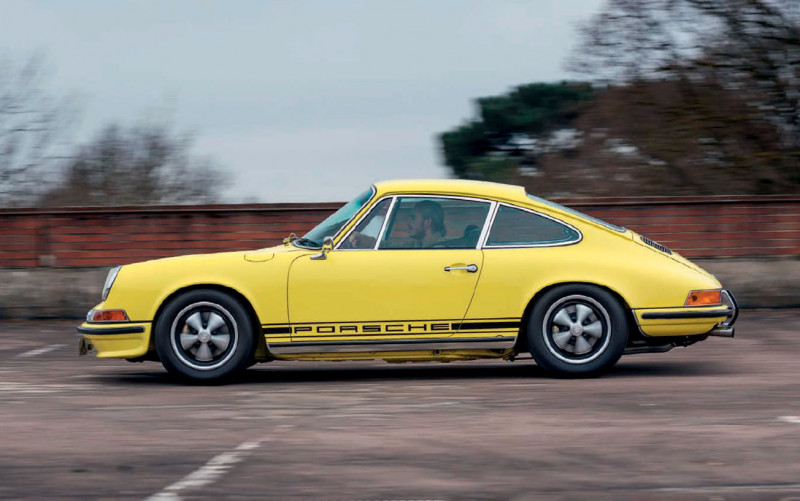
Away from ducktails and attacks of the track, in terms of mainstream 911s, the 2.4-litre S was very much top of the range. Early examples are now highly sought after and often replicated, their rarity encouraging many restorers to add dummy oil tank filler flaps to the rear quarters of their similarly aged or backdated 911s for aesthetic (non-functional) purposes. The Light Yellow S-badged belter you see here, however, is the real deal, complete with fully functional filler flap. Try saying that after a night on the shandies.
POWER AND STYLE
Assembled in 1972, the brightly coloured air-cooled classic is the personal Porsche of Paul Percival, hairdresser to the stars and founder of Percy & Reed, a salon and hair product retailer located in Great Portland Street, known informally as Motor Row on account of it being London’s go-to hub for car sales and automotive accessories in the early twentieth century. Fitting then, that a man whose blood has its own octane rating — as we’ll discover, this isn’t his first outstanding classic 911 — should set up shop in a location such as this.
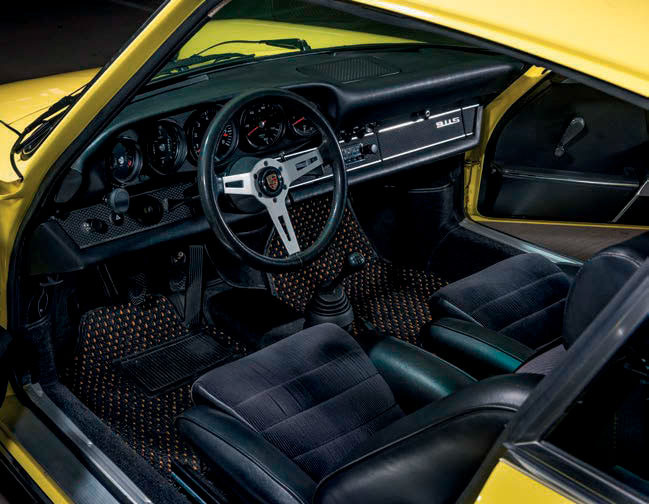
His father, Stephen, purchased the car from independent Porsche sales specialist, Paragon, in 2016 following an extensive multi-year restoration carried out by the previous owner in Germany, where the Porsche was originally registered. “A Porsche parts supplier named Vincenzo Seifert had amassed a huge inventory of original components for classic 911s, with special focus on the 2.4-litre S,” Paul explains. “His dream was to produce a concours-quality example of the model, as though it had just rolled out of Zuffenhausen in 1972.” The first part of Vincenzo’s plan was to source a willing example of the rare Porsche, complete with its original engine and running gear. As luck would have it, in 2011, he found exactly what he was looking for within eighty miles of the Porsche factory in Stuttgart. His huge stockpile of spares could finally be put to good use. To begin with, the car’s body was stripped bare, with all parts logged and tucked away in readiness for refurbishment. The remaining shell was then media blasted and subjected to the removal of any detected rust. As documented by a whopping 1,692 photographs illustrating not only the restoration work, but also every new part fitted, all damaged panels were repaired (where possible) or replaced with genuine Porsche parts matching original specification. When repair and restoration of the metalwork was complete, the shell was etched and primed with OEM-quality coatings before being dressed in Light Yellow (paint code 6262, fact fans), the same colour it wore on Porsche’s assembly lines exactly fifty years ago.
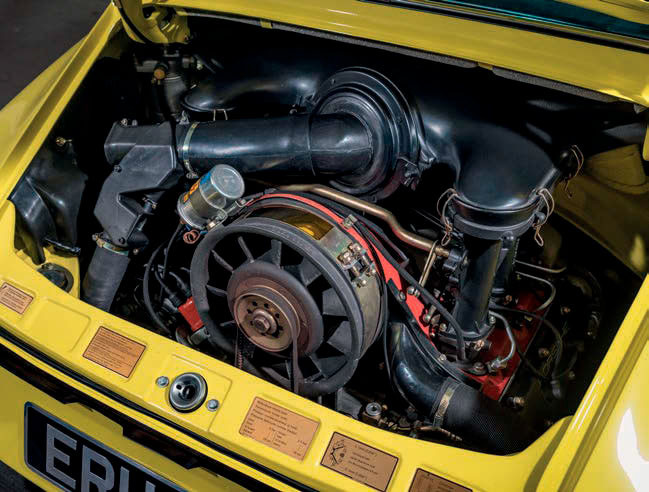
The painstaking process of reassembling the car now proceeded to the next stage. To support Vincenzo’s aim of creating a concours 911, the build followed official Porsche technical guidelines, with no detail left unattended. As so often happens with projects like this, however, the fine line between ambition and obsession became increasingly blurred — the huge amount of time, effort and money invested in the project took their toll on Vincenzo, who, after toil spanning four years, finally finished his Porsche passion project, but needed to sell the completed car to claw back numbers missing from his bank balance. Looking every inch factory fresh, the resurrected 911 came to the attention of Jürgen Meinhart, an automotive vehicle appraiser determining values of vintage vehicles for insurance companies in Germany. Through his business connections and friendship with Paragon founder, Mark Sumpter, the car made its way to the British company’s premises in East Sussex. It was here Paul’s father first set eyes on the pretty Porsche. To say he was bowled over would be an understatement — Vincenzo’s fanatical attention to detail and dedication to authenticity through the use of rare original Porsche parts had resulted in one of the most beautifully presented Stuttgart-crested sports cars Percival the Elder had ever seen.
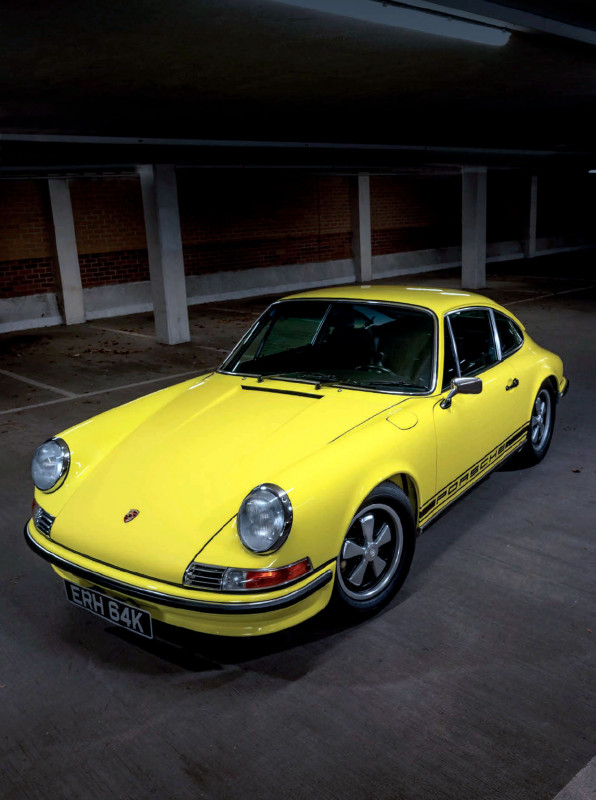
The fifteen-inch Fuchs wheels were like new, the original Blaupunkt head unit worked as intended, the extremely desirable black leatherette and corduroy-stitched sports seats (with head rests) was nothing short of eye-popping. The biggest draw, however, wasn’t the fact this 911 had covered only 587 miles since Vincenzo had finished the restoration, nor was it the presence of a rare long-range fuel tank. It was the revelation he’d blended the simple styling of the original 911 S 2.4 with the firepower of the later Carrera RS 2.7.
“When it comes to Porsches, Dad is an absolute perfectionist,” Paul tells us. “The no-compromise execution of the restoration is exactly in keeping with his mindset, which is why he didn’t hesitate in buying the car after seeing it in the metal at Paragon.” At the time, Paul was the owner of an Ivory-finished 1968 short-wheelbase two-litre 911. “It was a beautiful Porsche exhibiting just the right amount of patina,” he recalls. “I loved the car and considered it the perfect driving machine, despite it producing only 140bhp. I couldn’t believe the power of Dad’s 911 S, though. The engine has been properly built to RS specification,” he gasps, recognising this special Porsche offers just as much ‘go’ as ‘show’.
As owner of an AMG-authored Mercedes-Benz propelled by a torquetastic 6.2-litre V8, he acknowledges 210bhp from an air-cooled flat-six isn’t the stuff of headlines in today’s automotive environment. That said, we’re talking about a 911 weighing little more than a tonne. “You don’t need to be going fast to feel an integral part of this car,” he stresses. “A bash around B-roads or up mountain twisties is so engaging, you really don’t need to be travelling at crazy speed to feel completely engaged in the driving experience — reach beyond 4,000rpm, and the noise from the flat-six is nothing short of exhilarating. The buzz comes from pushing the car hard, but without having to travel at 80mph. To get the same thrill in a modern car, you need to be motoring along at license-losing pace.”
Paul used his two-litre 911 at every available opportunity, including for frequent road trips across the French Alps, but when his father was considering the future of the restored 911 S, the pair reached a sensible decision — Paul would part with the older Porsche and take on ownership of the custard-coloured car, thereby ensuring it remained in the family. His role as hairdresser to celebrities on film sets and magazine photo shoots, combined with his determination to use his cars whenever possible, meant he was almost certainly going to be adding more miles to the odometer than Stephen, which is why Uckfieldbased Precision Porsche was subsequently tasked with renewal of suspension rubbers.
While it’s great to know Vincenzo was in possession of such a massive haul of original, unused Porsche parts to use during the restoration, it’s true to say rubber bushes and seals can deteriorate with age, not just wear. Using items which had been sitting in his storeroom for two decades was very convenient, but there was risk they might need to be replaced sooner than anticipated after application. This is especially true of suspension and steering components. Sure enough, after Paul gave the car a once-over, Precision Porsche was given with the job of replacing steering knuckle bushes. Play in the steering rack, meanwhile, encouraged installation of a close-ratio unit. “It’s a change which has delivered a more direct link between user input and what the car is doing,” Paul suggests. “Adding to the effect, I replaced the factory steering wheel with a smaller-diameter MOMO threes-poke, supplied by classic Volkswagen and Porsche parts retailer, Karmann Konnection.”
Introducing additional functionality for forthcoming road trips across the continent, the team at Precision Porsche installed a Rennline ExactFit magnetic smartphone mount, hidden USB charging points, an advanced vehicle tracking system and Bluetooth speakers. They also removed and resealed the large-capacity fuel tank, which should enable Paul to cover big distance without the need to stop at as many fuel stations as his two-litre 911 demanded.
“The way this car pushes on and handles, plus the build of the 2.7-litre engine to exacting standards, means I have every faith in its ability to perform abroad without fault, as it has done during trips all over the UK. Pleasingly, the large fuel tank means I can also look forward to hammering on through Europe without the need to pause my journey prematurely.”
BUILT TO BE USED
Precision Porsche services the car twice a year, irrespective of distance covered. Additionally, whenever the 911 is in the company’s workshop, the MFI system is adjusted to suit seasonal changes in ambient temperature, the Fuchs five-leaves are removed and the underside of the car, as well as its inner wheel arches, are thoroughly cleaned. As Paul puts it, “this Porsche gets a huge amount of maintenance when you consider the relatively low mileage it covers, even with road trips taken into consideration.” If he’s asked to work on location and can carry everything he needs in the front of the 911, it’s his first choice of transport. “I’ve enjoyed fantastic five-day drives zig-zagging across Snowdonia and trips down to the Sussex coastline,” he says. “The pandemic temporarily put paid to plans for overseas trips, but I’m looking forward to driving this 911 down to Portofino on the Italian Riviera in the coming weeks.”
This is clearly a Porschephile who believes in using his cars. Paint protection film applied by Super Car Paint Protection helps, of course, but there are certainly owners who would be less inclined to use a 911 so utterly flawless in its presentation. “It’s difficult to reconcile European road trips with fear of stone chips,” he smiles. “You’ll always encounter stones getting flicked in the air by other vehicles when travelling big distances. There are measures you can take to minimise danger of damage, but ultimately, you should just enjoy the drive and not worry about it. Get out there and make some memories.” Some people go a step further, fondly suggesting every stone chip tells a story. Whether you subscribe to this train of thought or not, there’s always the opportunity to treat your car to a front-end respray if cosmetic damage reaches an unacceptable level. After all, air-cooled Porsches were built to be driven, right?!
During our exchange, Paul talks of his celebrity clientele. Pop singer, Will Young, is namechecked. “We’re fantastic friends. He’s godparent to my children,” reveals the Babyliss global ambassador, proudly. The Friday’s Child star is also a fan of vintage Porsches and once owned a 356 Speedster, though the fate of the car is rather less positive than that of the yellow 911 seen here. “I encouraged Will to buy an air-cooled Porsche and was thrilled when he called to say he’d bought a black Speedster. This was more than a decade ago. Unfortunately, due to his job requiring him to travel all over the world, resulting in him often being away from home on promotional tours for months at a time, he didn’t get to use the car as much as he’d anticipated. Recognising the need to keep it safe while he was abroad, he placed the Porsche in storage at a sheltered car park near his home in London.” What happened next beggars belief.
REQUIEM FOR A DREAM
Despite the storage facility having its own round-the-clock security operatives supposedly keeping an eye on things, they failed to notice two tramps had taken up residence inside the rare Porsche. “When I tell you they properly lived in it, consider all the implications this statement brings,” grimaces Paul. Unfortunately, the Speedster’s uninvited inhabitants managed to wreck the car, beginning with its interior, then working their way around the body. Naturally, upon discovering the state of his prized Porsche, Will was horrified, a sentiment which soon made way for anger at the fact his 356 was allowed to be abused. Soon, however, he was overcome with guilt, as though his absence behind the wheel was responsible for the car being ruined. “He ended up selling it, which was a real shame, especially considering what Speedsters are worth today,” Paul remarks.
No chance of the same ill fortune befalling the 911 S seen here. “I’m with the car as often as possible,” he says. “It’s a beautiful thing, amazing to look at. The colour is a big part of the appeal. My Ivory 911 was stunning, but this Porsche always makes people smile, wherever I go, including when the car is parked in the street outside my salon. And the handling is staggering, especially when you consider the fact I’m in charge of a fifty-year-old sports car riding on standard-specification suspension. The relocated oil tank pushing weight forward makes a big difference in this regard.” We love it — if only Porsche had built enough examples of the early 911 S 2.4 to go around.
Above Oil tank filler flap was a feature of the 1972 model year and is often replicated on air-cooled 911 backdates. Above and below Every aspect of this 1972 911 S is immaculate, the result of a restoration concerned with accuracy and detail. Above and below Every aspect of this 1972 911 S is immaculate, the result of a restoration concerned with accuracy and detail. Above Paul is a Porschephile who believes in using his cars at every available opportunity. Above Interior hides modern comfort tech making long drives perfectly pleasurable in modern traffic Below Engine has been rebuilt to Carrera RS 2.7 spec. Above Black Porsche script decals are the perfect finishing touch to this classic 911’s beautifully bright body Below The car was in near perfect condition when it joined the Percival family, but now drives even better thanks to renewal of chassis rubbers.


